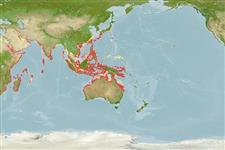Common names from other countries
Classification / Names / Names
Common names | Synonyms | Catalog of Fishes (gen., sp.) | ITIS | CoL | WoRMS
Environment: milieu / climate zone / depth range / distribution range
Ecology
Reef-associated; depth range 0 - 30 m (Ref. 848). Tropical; 36°N - 27°S, 32°E - 155°E (Ref. 848)
Indo-West Pacific: East Africa, including Red Sea, Indonesia to Papua New Guinea, north to Japan and south to Australia.
Length at first maturity / Size / Weight / Age
Maturity: Lm ? range ? - ? cm
Formation: encrusting to massive, often over 1 m across. Corallites: cerioid. Septa: with exsert teeth. Fleshy tissue over the skeleton present, but not thick enough to mask underlying skeletal structures. Color: mottled shades of brown and green, usually with brown walls and green oral discs (Ref. 848).
Occurs in most reef environments (Ref. 848), specifically in mid-reef slopes (Ref. 98471).
Life cycle and mating behavior
Maturity | Reproduction | Spawning | Eggs | Fecundity | Larvae
Members of the class Anthozoa are either gonochoric or hermaphroditic. Mature gametes are shed into the coelenteron and spawned through the mouth. Life cycle: The zygote develops into a planktonic planula larva. Metamorphosis begins with early morphogenesis of tentacles, septa and pharynx before larval settlement on the aboral end.
Veron, J.E.N. 2000. (Ref. 848)
IUCN Red List Status (Ref. 130435)
CITES status (Ref. 108899)
Not Evaluated
Human uses
| FishSource |
Tools
More information
Age/SizeGrowthLength-weightLength-lengthMorphologyLarvaeAbundance
Internet sources
Estimates based on models
Preferred temperature
(Ref.
115969): 24.8 - 29.2, mean 28.4 (based on 2924 cells).
Price category
Unknown.
